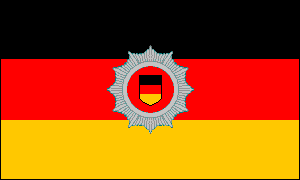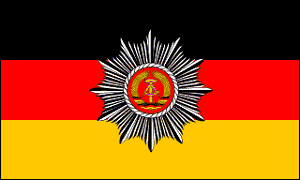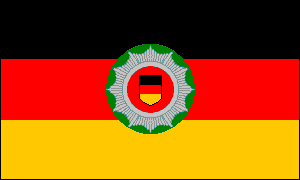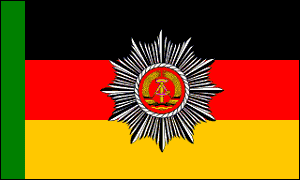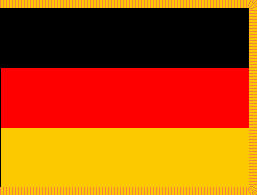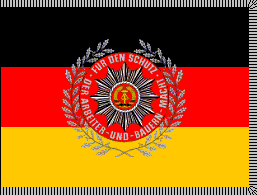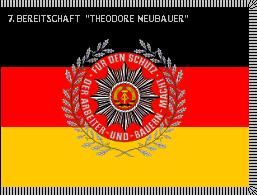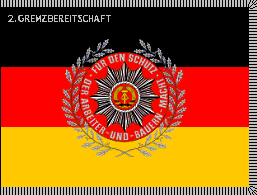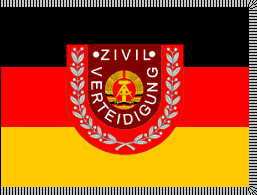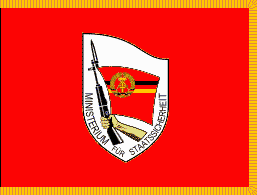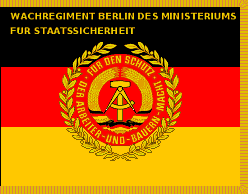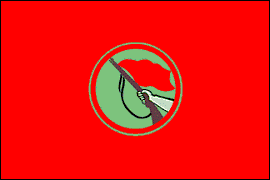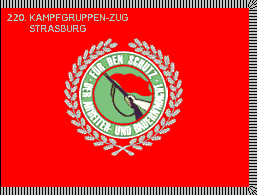GERMAN DEMOCRATIC REPUBLIC
Police & Security Service Flags • 1949-90
Image Added March 2019
Civil Defense Standard
The Deutsche Demokratische Republik (German Democratic Republic or DDR) was formed in 1949 from the Soviet sector of occupied Germany. The historic black-red-gold tricolor of 1848, which had also been used by the Weimar Republic from 1918 to 1933, was adopted as the flag of the new state. In 1959, however, the arms of the DDR were added to distinguish it from the flag of the Federal Republic of Germany (West Germany).
As a Soviet satellite, the DDR's foreign and domestic policies were largely dictated by the Soviet Union, and there was much popular unrest. Not surprisingly, therefore, the first armed force raised by the new state was the Deutsche Volkspolizei (German People's Police or DVP), responsible for both internal order and border control under the direction of the Ministry of the Interior. Service flags for the DVP and the DVP Border Guard (Deutsche Grenzpolizei) were introduced about 1950; they were black-red-gold tricolors with the traditional German "police star" in the center containing a shield striped in the national colors. The Border Guard flag displayed the star on a green disc, green being the Border Guard branch color. The Kasernierte Volkspolizei, established in 1952, was a paramilitary force similar to the barracks police of the Nazi era. Its grim task was the maintenance of internal order and to that end it was organized, trained and equipped along military lines. Its standard was a plain black-red-gold tricolor with a gold fringe. In 1956 the Kasernierte Volkspolizei passed under the control of the newly formed Ministry of National Defense to form the initial units of the Nationale Volksarmee (National People's Army). To replace it, in 1960 the DVP raised a number of battalion-strength alert units (Volkspolizei-Bereitschaften or VPB). These mobile police battalions were equipped with trucks, armored cars, antitank and antiaircraft weapons, and light artillery. They were quartered in barracks around the country, enabling them to intervene rapidly in case of mass protests or civil disorder. Also in 1960, the Border Guard was transferred from the Ministry of the Interior to the Ministry of National Defense. However the flags and standards of the former Deutsche Grenzpolizei seem to have remained in use for several years.
With the introduction of the 1959 national flag, the police flags were revised to display the new badge of the DVP: the state arms within a police star The DVP also had fringed standards (colors); these were similar to the standards of the Army (NVA), but with the police badge and silver instead of gold wreaths, inscriptions and fringe. Up to 1979 the Civil Defense organization (Volkspoliziei-Zivilverteidigung) used the standard of the DVP; in that year it was granted a distinctive standard bearing its badge.
The Ministry for State Security (Ministerium für Staatssicherheit or Stasi) was the all-pervasive, much-feared secret police service of the DDR: "The Shield and Sword of the Party." Its standard was red with the Stasi badge centered. The Stasi's Dzierzynsky Guard Regiment (named in honor of the founder of the Bolshevik secret police), stationed in Berlin, was responsible for the security of government facilities and officials, and the maintenance of public order. Its personnel wore Army uniform with special badges and the unit was organized as a motorized rifle regiment, though with many specialized units attached. By the time of the DDR's collapse, its strength was over 11,000 officers and men—equivalent to an Army division. The Dzierzynsky Guard Regiment's standard was of the Volksarmee pattern.
The Combat Groups of the Working Class (Kampfgruppen der Arbeiterklasse or KdA) was a paramilitary organization raised in 1953 in response to the worker uprising of that year. Officially it was a Party-affiliated “people’s militia” rather than a branch of the DDR armed forces and as such it came under the authority of the Central Committee of the ruling Socialist Unity Party. Training was provided by the Volkspolizei—this to avoid having to count the KdA as part of the armed forces under international treaties. KdA units were based in the workplace: factories, public utilities, government administration offices, etc. Mostly they were given strictly local tasks, but there were a number of mobile units, called Battalions of the Regional Reserve, that could be deployed throughout the country. Each KdA battalion (Zug) was granted a standard.All these flags were abolished in 1990 when the DDR collapsed and was incorporated into the Federal Republic of Germany.
Flag Proportions: Most GDR flags and ensigns were made in the traditional German 3:5 proportions.
